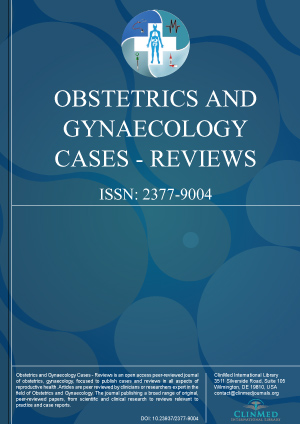Open Access DOI:10.23937/2377-9004/1410025
Expectant Management in Cesarean Scar Pregnancy
Natasha Gupta
Article Type: Letter | First Published: February 27, 2015
The incidence of pregnancy implantation at unusual sites like cesarean scar, cervix or ovaries is on rise due to the increase in incidence of cesarean sections, dilatation and curettages and pelvic inflammatory diseases. Diagnosis of these rare types of ectopic pregnancies is extremely challenging. Cesarean scar ectopic pregnancy as well as cervical pregnancy can be easily confused with each other or with an inevitable abortion....
Open Access DOI:10.23937/2377-9004/1410023
Uterine Artery Embolisation for the Treatment of Large Submucosal Fibroid (Clinical Case)
Dobrokhotova J, Grishin I, Khachatryan A, Causeva O, Zlatovratsky A and Rogovskaya S
Article Type: Case Report | First Published: February 09, 2015
Article is devoted to the problem of endovascular treatment of uterine fibroids - Uterine Artery Embolization (UAE). A number of researches do not promote to use UAE technique when the uterine fibroid has submucosal position, considering the conservative transcervical myomectomy to be more accessible. In the article, based on clinical case, indication of EMA at the large submucous uterine fibroid among women that are still in their reproductive age as an alternative to a hysterectomy is discusse...
Open Access DOI:10.23937/2377-9004/1410022
Intra-operative Management of Skull Remnant Discovered during Emergent Primary Cesarean Delivery
Lisa A. Licare and Suruchi Thakore
Article Type: Case Report | First Published: February 08, 2015
Background: Operative anticipation of patients with prior abdominal surgeries is critical for the evaluation of obstetric patients. The following case demonstrates the importance of preoperative planning before emergent surgery is indicated. Case: T.M. is a 26 year- old gravida 8, para 0161 at 24 weeks 5 days who presented with preeclampsia with severe features. Her history is significant for brain surgeries with abdominal skull flap preservation. She required an emergent cesarean where a skull ...
Open Access DOI:10.23937/2377-9004/1410021
Arteriovenous Malformation of the Cervix: A Rare Cause of Vaginal Bleeding after Supracervical Hysterectomy
Nigel Pereira, Kayla M Wishall, Gabrielle M Hawkins, Nima R. Patel and Carl R. Della Badia DO
Article Type: Case Report | First Published: January 30, 2015
Background: Cyclic vaginal bleeding is a well-known complication after a supracervical hysterectomy; however, severe delayed vaginal bleeding occurs infrequently. Case: A 29-year-old woman underwent a supracervical hysterectomy for dysmenorrhea and pelvic pain refractory to multiple medical modalities. Eight weeks after surgery, the patient began to experience persistent heavy vaginal bleeding that continued in spite of application of silver nitrate to the cervical stump. The patient subsequentl...
Open Access DOI:10.23937/2377-9004/1410020
Endoscopic Conservative Treatment for an Ureterovaginal Fistula Caused by Foreign Body
DeLeon E, Lankford D, Allman D, Phillibert D, Paolucci M, Gore S and Clare C
Article Type: Case Report | First Published: January 20, 2015
Foreign body placement in the vagina is a rare cause of ureterovaginal fistula. A fistula is often due to an unrecognized injury to the ureter, most commonly after gynecologic pelvic surgery, such as during hysterectomy for benign indications. This manuscript will discuss a case of a 34-year-old African American female who presents with a history of sexual assault and a one month history of urinary incontinence. Physical examination revealed clear liquid in the vaginal vault and a malodorous for...

